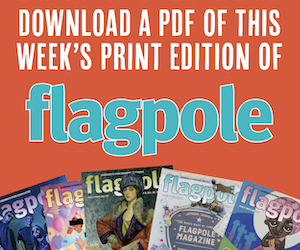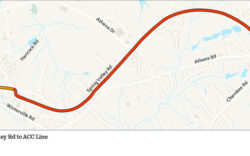Athens-Clarke County is experiencing a housing crisis, with both sale prices and rents rising well beyond the reach of working- and middle-class people. One solution, as mapped out by recent studies on affordability and “missing middle” housing, is to tweak zoning laws to allow different types of housing in single-family neighborhoods, like duplexes, fourplexes, accessory dwellings and tiny homes. Additional density, though, is often politically unpopular and opposed by residents in the areas where it is proposed.
These types of hard questions are at the heart of the major issues that ACC’s ongoing review of its future development map and zoning code are going to have to address. And they were on full display at last week’s planning commission meeting.
Micah’s Creek is a proposed subdivision off Little Oak Street in East Athens, half a mile east of downtown, that would include 63 houses ranging from one to three bedrooms and 384–1,170 square feet, on lots mostly under 5,000 square feet. As an Athens Area Habitat for Humanity project, it would be subsidized by “sweat equity” from the homebuyer and volunteers so that mortgage payments would be around $400 a month. Some houses would go to buyers participating in a study on how home ownership affects educational outcomes for children from low-income families, and some would go to college students who’ve aged out of the foster care system and have no support from parents or the government.
County planners praised the infill development’s mix of housing sizes and styles, and its connections to Athens Transit, Firefly Trail, the Greenway and Dudley Park. They also raised concerns about lack of parking, and proposed combining some of the tiny homes into attached units to make room for greenspace or community space.
Several nearby residents echoed those concerns, wondering where children would play, where visitors would park and where residents would store their lawnmowers. They said they support Habitat but want to see the development scaled back—less dense.
“They have no front yard or back yard. They have no privacy,” Cooper Holmes said. “It just doesn’t seem like a very desirable place to live in.”
Habitat combined nine parcels to create the 11-acre tract, and is asking for a rezoning and a total of eight waivers to build Micah’s Creek. The rezoning would allow one additional home per acre, according to Justin Crighton of W&A Engineering, which is designing the development, meaning 11 more families who would have the opportunity to buy a home. Some of the waivers have to do with ACC’s minimum parking requirements, minimum lot size and minimum square footage that would prohibit such a development.
“I think it’s important to remember who’s going to be living in these houses. These are Habitat families who aren’t going to be your typical two-car households. They’re going to be college students, veterans, musicians, people who are either looking to downsize or don’t necessarily need a lot of room for storage or maneuvering automobiles,” Crighton said. “A lot of the design of suburban residential units everywhere is designed around the storage of automobiles, and I think that’s silly. This development focuses more on people, on their homes, and it’s a good step in the right direction for Athens-Clarke County.”
One planning commissioner questioned the applicants and planning staff on why ACC has such rules. Senior planner Bruce Lonnee said the minimum size for a house in that area would ordinarily be 600 square feet. In zones with larger lots, it’s 1,000. “There’s been lots of community discussion about revisiting that, and that’s probably something that will be on the table in the near term,” he said. The actual space a person needs to live is far less—closer to 180 square feet, according to the county building code.
Before car ownership became widespread post-World War II, neighborhoods with mixed housing were common. In the South, zoning laws setting minimum lot sizes and such were a reaction to civil rights legislation and the end of legal segregation, Athens Habitat Executive Director Spencer Frye said, “when people wanted to preclude certain folks of socioeconomic status from moving into certain areas.”
Planning commissioners debated whether it was better to tell Habitat to scale back the density and ask for amenities like a playground, potentially at the expense of its affordability. They voted 6–1 to recommend that the ACC Commission approve the rezoning and grant the waivers.
The outcome wasn’t the same for another proposal to add density to an existing neighborhood. Applicant Blake Underwood is asking for a rezoning from RS-25 (half-acre lots) to RM-1 (the least dense multifamily category) to build 28 townhouses on five acres at Barnett Shoals Road and Forest Road, near the Green Acres subdivision.
“This development fits all the boxes our citizens and commissioners are looking for,” Underwood said, including easy access to stores, restaurants, transit, churches and jobs. It’s infill housing, not sprawl, and the density would still be a step down from the commercial development along Barnett Shoals.
Various proposals have been floated for that parcel dating back 20 years, including a pharmacy and an Aldi grocery store. All were thwarted by neighborhood opposition and the lack of access to Barnett Shoals—the parcel’s frontage is too close to, but does not align with, College Station Road. The most recent proposal would solve the latter problem by buying a house on Forest and knocking it down for an entrance.
A few residents spoke in favor of the proposal, but most of the 20 or so speakers were opposed to it, citing concerns about density, traffic, its impact on the deer population, stormwater drainage, the loss of tree canopy and “spot zoning,” where a tract is zoned in a way that doesn’t bear any relationship to its surroundings. Opponents also expressed a belief that parents of students at the nearby UGA College of Veterinary Medicine would buy up the townhouses, rather than families, although Underwood said it is not designed to appeal to college students.
Eastsiders continue to hold out for something better. “We don’t want to settle,” Green Acres resident Kent Middleton said.
Planning staff recommended denial, and the planning commission agreed, voting 4–3 against the request. It will now go to the county commission for a hearing as early as Nov. 16 and a final vote Dec. 5.
CCSD Renames Two Schools
The former Alps Road and Chase Street elementary schools are now officially known as Bettye Henderson Holston and Johnnie Lay Burks, respectively, after formal renaming ceremonies on Nov. 3. Both schools are now named after their first Black teachers.
Holston, a native of Monticello, followed her mother and aunt into the teaching profession after graduating from Fort Valley State University. In her 10th year of her career, she applied for a job at CCSD and was assigned to the then-segregated Alps in 1966. Later, she transferred to Chase and won Teacher of the Year in 1975. She retired from Timothy Road Elementary in 1985.
Burks was valedictorian and class president at her high school in Winder and graduated from Clark College, now Clark Atlanta University. After a brief time in Ila, she taught at the all-Black East Athens School, and in 1966 then-superintendent Samuel L. Wood approached her about integrating the faculty at Athens’ all-white schools. She taught briefly at Alps before transferring to Chase in 1966. Burks went on to earn advanced degrees from UGA and become a middle-school counselor, winning Counselor of the Year while at Clarke Middle in 1986.
The Clarke County Board of Education voted to rename the two schools back in February, but it took some time before new insignias and signage could be made.
Like what you just read? Support Flagpole by making a donation today. Every dollar you give helps fund our ongoing mission to provide Athens with quality, independent journalism.








